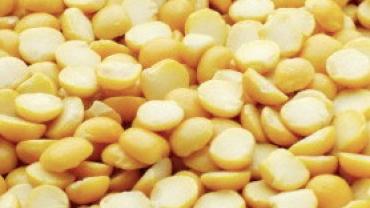
Peas: love them or hate em; there aren't many opinions in between. They either induce thoughts of sweet tender green peas fresh from a summer garden steamed with a pat of butter and a sprinkle of salt for good measure or they evoke painful memories of being forced to choke down a bowl of overcooked gray mushy stuff in order to earn dessert. But whatever your opinion of peas may be with the introduction of pea powders modern technology allows us to take advantage of something positive peas offer that being protein without some common drawbacks.
Being a member of the legume family peas contain a relatively high amount of protein compared to other plant foods. And because they are a plant protein they present none of the allergenic problems of dairy-derived proteins like whey and casein. Pea protein is an ideal source of additional amino acids for those who have genuine milk allergies or for those with varying degrees of lactose intolerance.
Where's the joy in soy?
Pea protein also sidesteps the problematic aspects associated with soy protein. Pea protein can be considered the quintessential source of supplemental protein for vegetarians and vegans who require protein from plant sources but for whom soy can be difficult to digest. It is also superior in order to avoid the potential estrogenic effects of soy. Also unlike most commercially available non-organic soy products pea protein currently escapes the stigma surrounding genetically modified organisms in the food supply and their potentially deleterious effects on health. The low allergenicity and easy digestibility of pea protein makes it a better choice than soy for supervised detox programs particularly because many of the patients undertaking a detox may be doing so specifically to strengthen weakened digestive systems or to rebalance hormones. And considering soy is among the most common food allergens it seems like a less-than-ideal choice for strengthening digestion and healing the gut.
Despite the nearly ubiquitous use of soy protein in shakes bars cereals and other protein-fortified products soy's reputation as a health food rests on shaky ground. Small amounts of edamame properly prepared aren't problematic but the refinement of soy into isolated protein fractions concentrates some of the antinutrients that lead to the unpleasant digestive effects some people experience from soy consumption such as gas bloating and loose stools. A meta-analysis of studies on soy safety resulted in mixed conclusions and the authors recommended “moderate amounts of traditionally prepared and minimally processed soy foods rather than the consumption of large amounts of highly refined and isolated soy protein.
Soy consumption is often recommended for women with elevated estrogen levels because the weak estrogenic effects of soy phytoestrogens are believed to attenuate the more potent effects of natural estrogen. However soy is also recommended for post-menopausal women precisely due to its estrogenic effects as a kind of natural hormone replacement. Soy phytoestrogens either do have potent hormonal effects or they don't. The marketing hype and extremely low cost of soy as a raw material allow food manufacturers to disingenuously play both sides. Soy is also a recognized goitrogen meaning it can negatively affect thyroid function particularly in people with inadequate iodine intake not uncommon in 21st century America. In the amounts that some vegetarians may be consuming soy (via soy milk protein powder cereals and soy-based meat and dairy substitutes) these potential endocrine-disrupting properties are important to consider.
Back to pea
Vegetarians aren't the only people who can benefit from pea protein. Pea protein is relatively high in branched chain amino acids (leucine isoleucine and valine) so athletes and bodybuilders may benefit from the bioavailability of these elements which are so critical for muscle growth repair and recovery.
Beyond the helpful role of supplemental protein in athletes pea protein may have beneficial effects on lipid profiles. In rats fed a hypercholesterolemic diet those fed pea protein had more favorable lipid profiles than those fed casein. Triglycerides and genes involved in fatty acid synthesis were lower and mRNA expression of LDL receptor genes higher in the pea protein-fed rats suggesting that the pea protein somewhat reduces the internal synthesis of fats while also possibly helping to facilitate the clearance of LDL particles from the bloodstream. Additionally compared to whey protein pea protein was shown to have short-lived but powerful anti-hypertensive effects in rats. The potential for pea protein to help reduce blood pressure is another reason to favor it over other sources when supplemental protein is needed in a program designed to support overall health.
All in all regardless of how you feel about their flavor in whole food form peas are a wonderful source of protein without the problematic aspects of the more common dairy and soy proteins. So even if peas rarely end up on your plate consider harnessing their beneficial qualities in the form of a quality protein powder.